Statewide Longitudinal Data System (SLDS) Survey 2020-2022
Statewide Longitudinal Data System (SLDS) Survey 2020-2022
Appendix E SLDS Survey 2020-2022 Instrument
Statewide Longitudinal Data System (SLDS) Survey 2020-2022
OMB: 1850-0933
National Center for education statistics
(nces)
Statewide Longitudinal Data System (SLDS) Survey 2020 –2022
OMB# 1850-0933 v.8
Appendix E – SLDS 2020 Instrument
January 2020
APPENDIX E – Sample Online Google Form Platform and Flat File Instrument
The online Survey platform is still in development. All questions proposed for the 2020 Survey collection are included in the Word version of the instrument, found below the preliminary online Survey form screenshots below. The following timeline is proposed to facilitate the shift from the instrument in flat file (below) to an online Survey form. An updated version of Appendix E, complete with new screenshots of the finalized instrument as well as a cleaner version of the instrument that will be distributed to respondents who are unable to complete the Google Form, will be included in the post-clearance change request, estimated for late Spring 2020.
-
Activity
Expected Completion Date
Draft survey in Google Forms
March 1, 2020
QA survey and skip logic
March 15, 2020
Revise survey and finalize
April 1, 2020
*Online Survey development takes place in tandem with Statistics in Brief development and ultimate release, currently utilizing the same staff for both processes. The release of the 2018 and 2019 collection Statistics in Brief documents have been prioritized as our commitment to release information and analysis back to the field as soon as possible.
Sample screenshot of online Survey form development (cover sheet).:
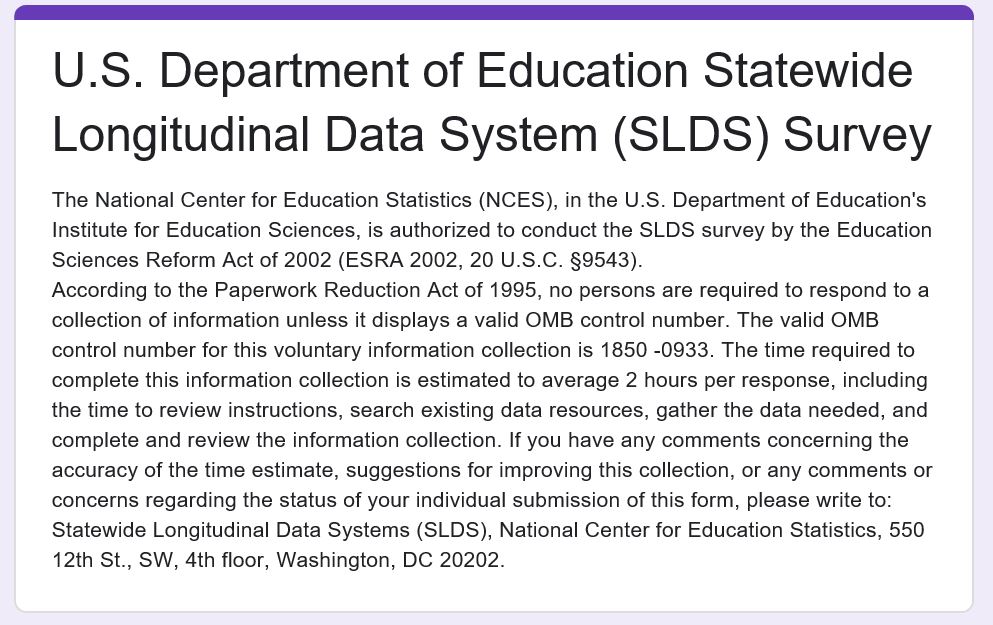
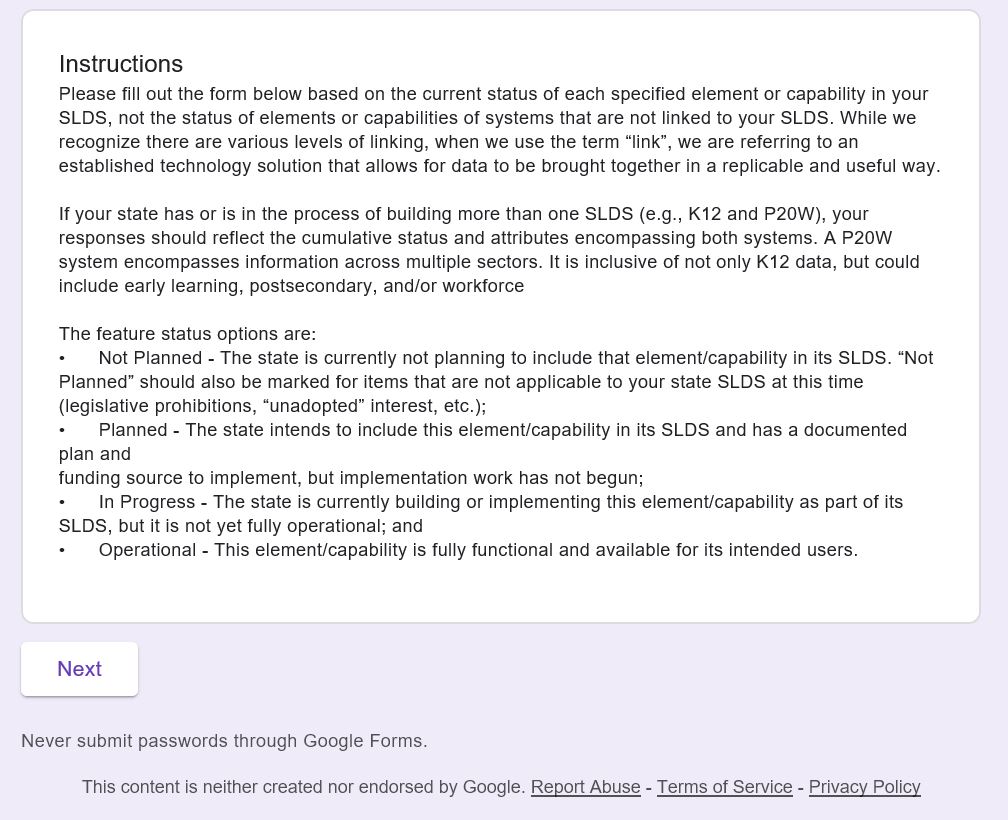
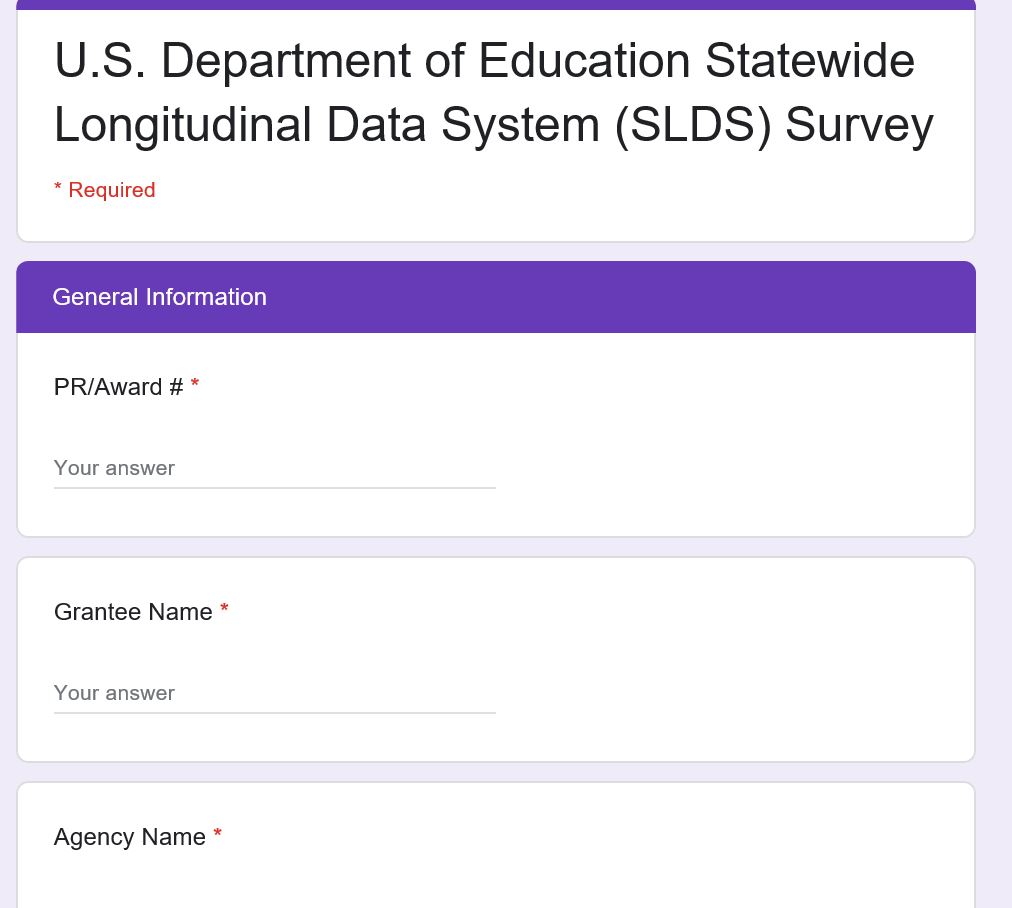
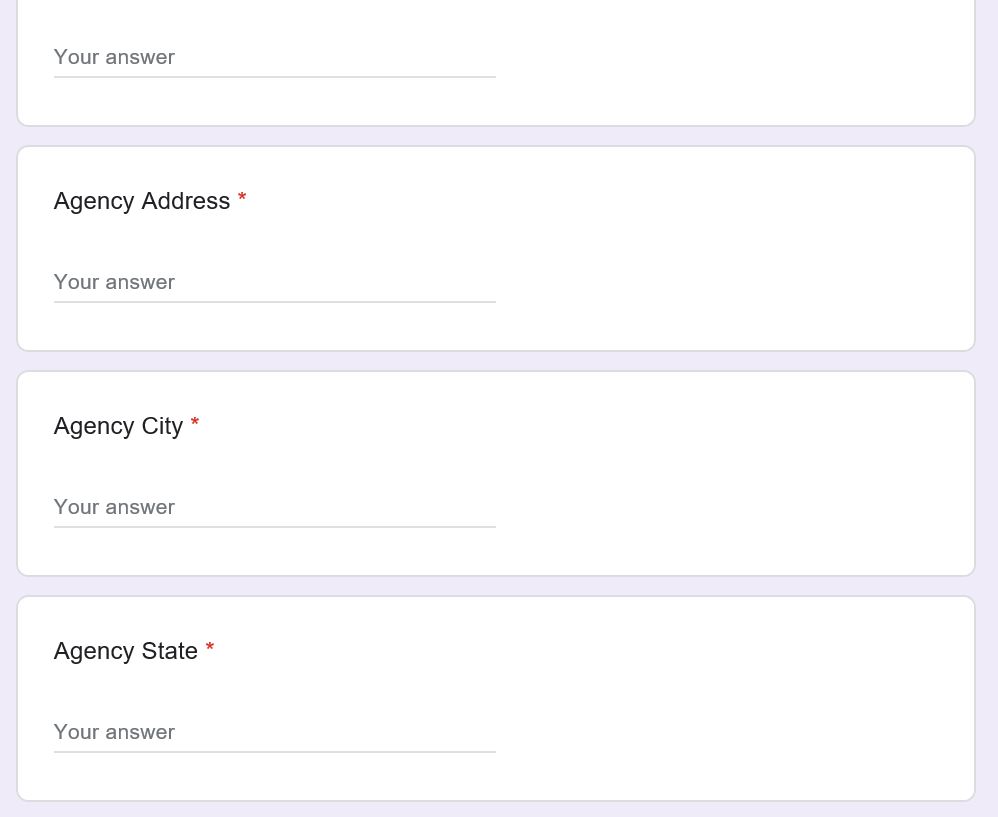
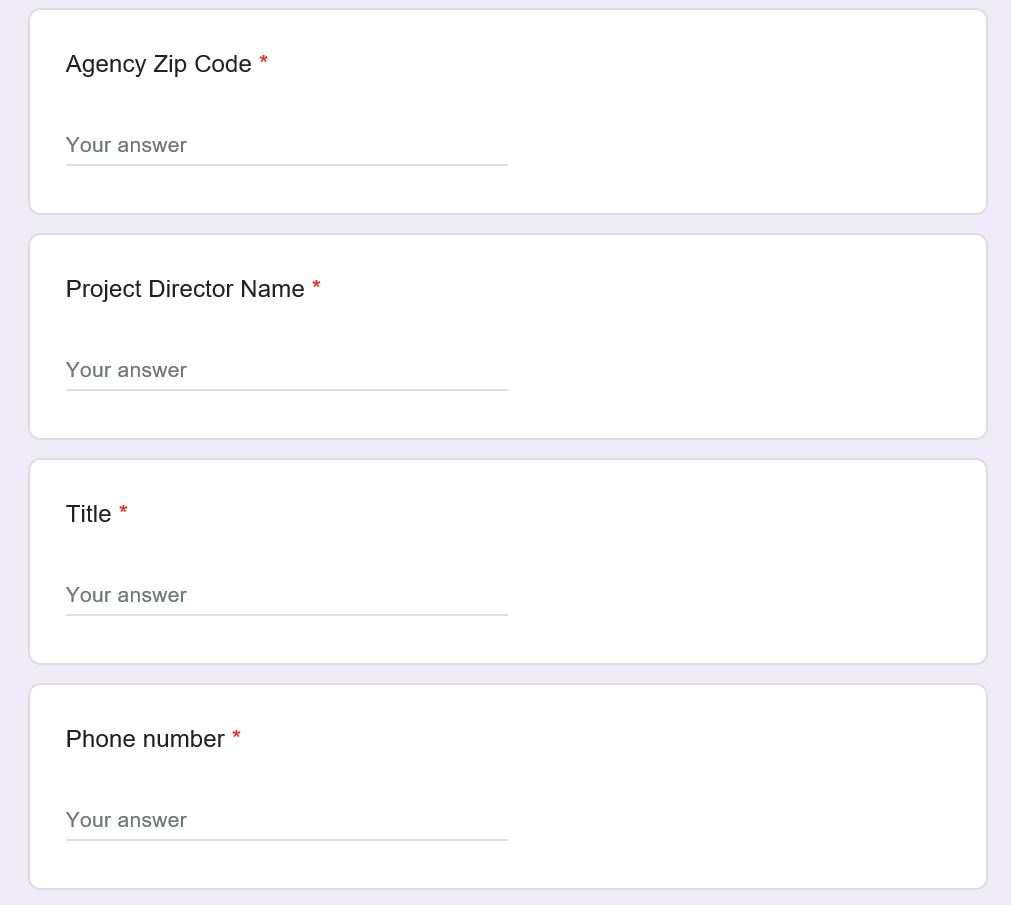
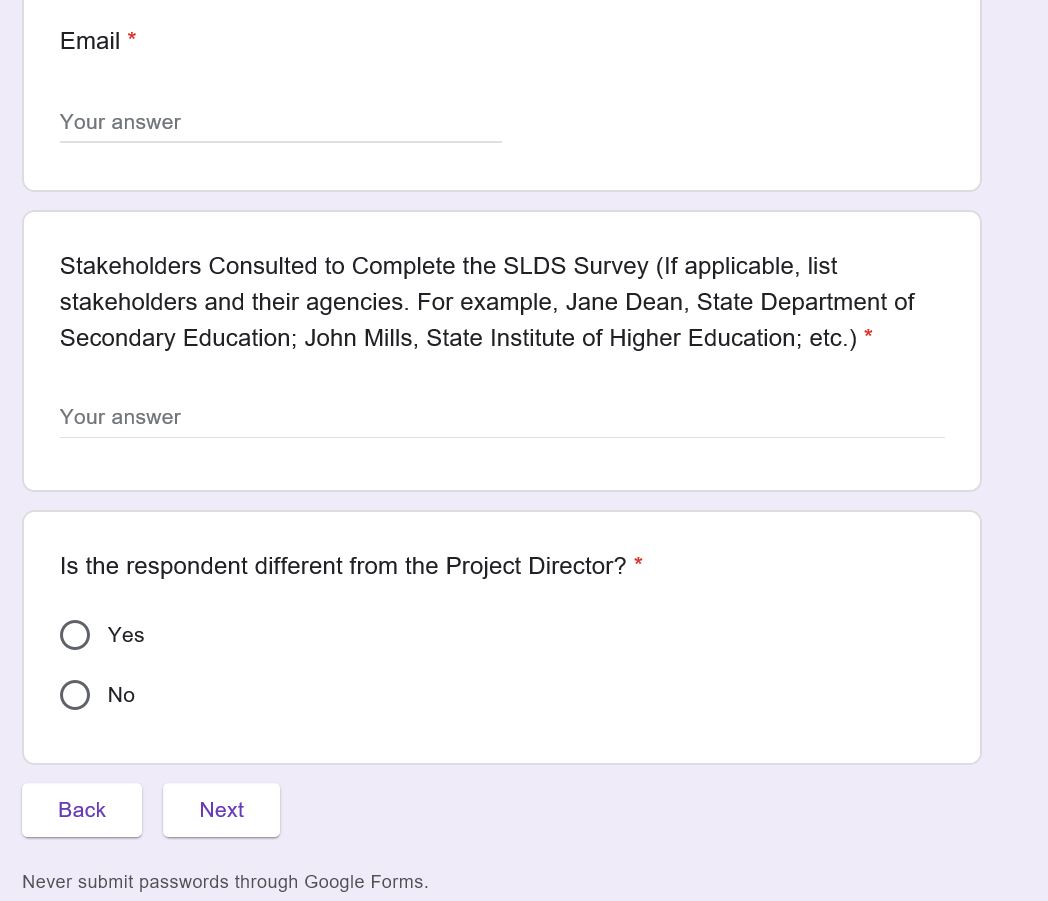
(Beginning of flat file instrument)

October 1, 2020
Dear Project Director and/or Primary SLDS Contact:
The National Center for Education Statistics (NCES) has initiated a data collection effort to help inform ongoing evaluation and targeted technical assistance efforts to enrich the quality of the Statewide Longitudinal Data System (SLDS) Program's support to States regarding system development, enhancement, and use.
This project is a formalized expansion of the SLDS Program's Interim Progress Report (IPR), which was intended to provide NCES with insight on State and U.S. territory SLDS capacity for automated linking of K-12, teacher, postsecondary, workforce, career and technical education (CTE), adult education, and early childhood data.
To ensure the success of the SLDS Survey, we need your help. Included in this package you will find the SLDS Survey and completion instructions. We encourage all respondents to complete the online version to ease both completion and analysis time. Should you have issues accessing or completing the online version of the Survey, please do not hesitate to contact us. We will accept completed surveys via email until the deadline of: November 15, 2020.
By providing NCES with information regarding the capacity of your State's SLDS, NCES will be able to provide a publicly-accessible set of metrics and use cases showing data-linking and use capacity by State in the form of a Statistics in Brief, which will enable interested users to quickly ascertain which States have capacity to link data across sectors. For example, which States can link K12, postsecondary, and workforce data, and how they are using these data to inform policy and practice. We also will use the data collected from the Survey to respond to questions from internal and external stakeholders regarding SLDS capacity in the States, and to inform future grant rounds and technical assistance planning.
The cooperation of your State is important to the success of this national survey of SLDS capacity. NCES will not sell these data and will notify you when the public metrics and use cases become available, in the form of an IES Statistics in Brief. The Survey data will be collected on an annual basis. SLDS system capacity changes frequently (ex. Infrastructure enhancements, evolving P20W agency collaborations, State legislation impacts, etc.), so collecting data less often would make the information too obsolete to be useful for targeted technical assistance planning.
If you have questions about the SLDS Survey, please contact Kristen King at Kristen.king@ed.gov.
Sincerely,
Ross Santy
Associate Commissioner, Administrative Data Division National Center for Education Statistics
Institute of Education Sciences
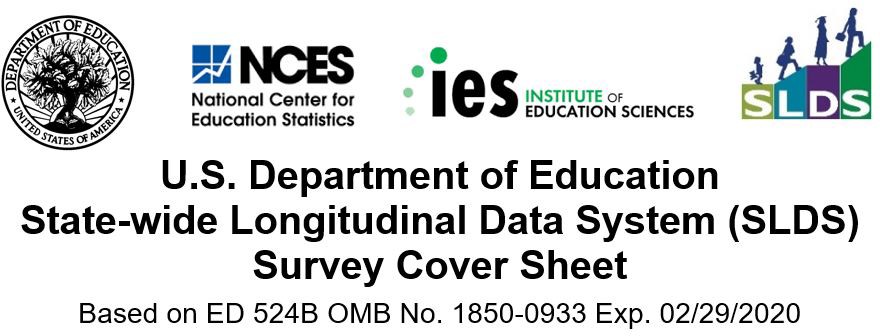
Reporting Period From: To:
General Information
PR/Award#:
Grantee Name
Agency Name
Agency Address
City:
 State: Zip:
State: Zip:
Project Director Name:
Title:
Phone #: Ext.:
Email:
Respondent Name:
(if different from the Project Director)
Title:
Phone #: Ext.:
Email:
Stakeholders Consulted to Complete the SLDS Survey
If applicable, list stakeholders and their agencies. For example, Jane Dean, State Dept of Secondary Education; John Mills, State Institute of Higher Ed; etc.

The National Center for Education
Statistics (NCES), in the U.S. Department of Education's
Institute for Education Sciences, is authorized to conduct SLDS by
the Education Sciences Reform Act of 2002 (ESRA 2002, 20 U.S.C.
§9543).
According to the Paperwork Reduction Act
of 1995, no persons are required to respond to a collection of
information unless it displays a valid OMB control number. The valid
OMB control number for this voluntary information collection is 1850
-0933. The time required to complete this information collection is
estimated to average 2 hours per response, including the time to
review instructions, search existing data resources, gather the data
needed, and complete and review the information collection. If you
have any comments concerning the accuracy of the time estimate,
suggestions for improving this collection, or any comments or
concerns regarding the status of your individual submission of this
form, please write to: Statewide Longitudinal Data Systems (SLDS),
National Center for Education Statistics, 550 12th St., SW, 4th
floor, Washington, DC 20202.
Instructions:
Please fill out the form below based on the current status of each specified element or capability in your SLDS, not the status of elements or capabilities of systems that are not linked to your SLDS. While we recognize there are various levels of linking, when we use the term “link”, we are referring to an established technology solution that allows for data to be brought together in a replicable and useful way.
If your state has or is in the process of building more than one SLDS (e.g., K12 and P20W), your responses should reflect the cumulative status and attributes encompassing both systems. A P20W system encompasses information across multiple sectors. It is inclusive of not only K12 data, but could include early learning, postsecondary, and/or workforce

The feature status options are:
Not Planned - The state is currently not planning to include that element/capability in its SLDS. “Not Planned” should also be marked for items that are not applicable to your state SLDS at this time (legislative prohibitions, “unadopted” interest, etc.);
Planned - The state intends to include this element/capability in its SLDS and has a documented plan and
funding source to implement, but implementation work has not begun;
In Progress - The state is currently building or implementing this element/capability as part of its SLDS, but it is not yet fully operational; and
Operational - This element/capability is fully functional and available for its intended users.
Feature |
Status |
Comments |
|||
Not Planned |
Planned |
In Progress |
Operational |
||
State Agency K12 Data |
|||||
1) Are K12 student data included in the SLDS? (If No, skip to 6) |
Yes |
No |
|
||
2) What types of K12 student data are included in the SLDS? |
|||||
|
|
|
|
|
|
Attendance |
|
|
|
|
|
b) Migrant status |
|
|
|
|
|
c) Homelessness status |
|
|
|
|
|
d) English language learner status
|
|
|
|
|
|
e) Special education status
|
|
|
|
|
|
f) Other program participation (e.g., free & reduced-price lunch or other SES indicator, Title I, and Section 504) |
|
|
|
|
|
e) Discipline |
|
|
|
|
|
f) Grade level |
|
|
|
|
|
h) Assessments: |
|||||
i) Kindergarten entry |
|
|
|
|
|
ii) Statewide summative/end of course |
|
|
|
|
|
iii) Statewide benchmark or interim |
|
|
|
|
|
iv) Local benchmark or interim |
|
|
|
|
|
v) Advanced Placement (AP) scores |
|
|
|
|
|
vi) Information on students not tested by grade and subject |
|
|
|
|
|
vii) College-readiness test scores (SAT, PSAT) |
|
|
|
|
|
i) School enrollment & completion |
|
|
|
|
|
j) Course enrollment |
|
|
|
|
|
k) Course completion |
|
|
|
|
|
l) Virtual school/learning enrollment or participation |
|
|
|
|
|
m) Diploma or certificate |
|
|
|
|
|
n) Drop out history |
|
|
|
|
|
o) Transfer in/out |
|
|
|
|
|
p) In-state postsecondary/dual enrollment |
|
|
|
|
|
q) Out-of-state postsecondary/dual enrollment |
|
|
|
|
|
r) Instructional methods used in the classroom
|
|
|
|
|
|
Selecting the CLEAR button will reset all answers for Question 2 |
CLEAR Q2 |
||||
Feature |
Status |
Comments |
|||
Not Planned |
Planned |
In Progress |
Operational |
||
3) Is there a comprehensive data dictionary for K12 student data elements that contains metadata such as a definition, option sets, type or field length? (If Not Planned, skip to 4) |
|
|
|
|
|
a) Is the data dictionary published publicly? |
|
|
|
|
|
i) If so, please provide data dictionary website address: |
|
||||
|
|
|
|
|
|
|
|
|
|
|
|
Selecting the CLEAR button will reset all answers for Question 3 |
CLEAR Q3 |
||||
4) How are K12 student data from the SLDS used? |
(If Not Planned, skip to 6) |
||||
|
|
|
|
|
|
Feature |
Status |
Comments |
|||
Not Planned |
Planned |
In Progress |
Operational |
||
Selecting the CLEAR button will reset all answers for Question 4 |
CLEAR Q4 |
||||
5) At what level(s) are K12 expenditure data reported?
|
|
|
|
|
|
K12 Teacher Data |
|||||
6) Where are K12 teacher data stored and managed? |
(If Not Planned, skip to 12) |
||||
a) Single sector SLDS |
|
|
|
|
|
b) P20W SLDS |
|
|
|
|
|
c) A separate, central teacher data system |
|
|
|
|
|
d) Separate, multiple teacher data systems or source files |
|
|
|
|
|
Selecting the CLEAR button will reset all answers for Question 6 |
CLEAR Q6 |
||||
7) Is there automated infrastructure in place to link K12 teacher data with K12 student data in the SLDS?
Note:
Any system that links in a standard, repeatable process should be
considered for this response. Ad hoc linking should not be
considered for this response. |
|
|
|
|
|
8) How are K12 teacher and K12 student data directly linked? |
|||||
a) Course assignment |
|
|
|
|
|
b) Statewide unique teacher IDs |
|
|
|
|
|
c) Roster verification process |
|
|
|
|
|
d) Other method (please explain in comments) |
|
|
|
|
|
Selecting the CLEAR button will reset all answers for Question 8 |
CLEAR Q8 |
||||
9) What type of K12 teacher data are directly linked with K12 student data? |
|||||
|
|
|
|
|
|
|
|
|
|
|
|
Certificate type |
|
|
|
|
|
b) Certification path (traditional v. alt-cert) |
|
|
|
|
|
Feature |
Status |
Comments |
|||
Not Planned |
Planned |
In Progress |
Operational |
||
c) Postsecondary program or major |
|
|
|
|
|
e) Preparation program or institution name |
|
|
|
|
|
f) Years of experience |
|
|
|
|
|
g) Salary |
|
|
|
|
|
h) Assessment results (e.g., Praxis) |
|
|
|
|
|
i) Course assignments |
|
|
|
|
|
j) Teacher or administrator evaluation data |
|
|
|
|
|
k) Instructional methods used in the classroom |
|
|
|
|
|
Selecting the CLEAR button will reset all answers for Question 9 |
CLEAR Q9 |
||||
10) How are K12 teacher data from the SLDS used? |
(If Not Planned, skip to 12) |
||||
|
|
|
|
|
|
Selecting the CLEAR button will reset all answers for Question 10 |
CLEAR Q10 |
||||
Feature |
Status |
Comments |
|||
Not Planned |
Planned |
In Progress |
Operational |
||
11) Are K12 teacher data linked to finance data? |
|
|
|
|
|
Postsecondary Data |
|||||
12) Where are postsecondary data stored and managed? |
(If Not Planned, skip to 19) |
||||
a) Single sector SLDS
|
|
|
|
|
|
b) P20W SLDS |
|
|
|
|
|
b) A separate, central postsecondary data system |
|
|
|
|
|
c) Separate, multiple postsecondary data systems or source files |
|
|
|
|
|
Selecting the CLEAR button will reset all answers for Question 12 |
CLEAR Q12 |
||||
13) Is there automated infrastructure in place to link postsecondary data with K12 student data in the SLDS? Note: Any system that links in a standard, repeatable process should be considered for this response. Ad hoc linking should not be considered for this response. (If Not planned, skip to 17) |
|
|
|
|
|
14) Who provides postsecondary data for the SLDS? |
|||||
a) State 4-year public institutions |
|
|
|
|
|
b) State 2-year public institutions |
|
|
|
|
|
c) State tribal institutions |
|
|
|
|
|
d) State private non-profit institutions |
|
|
|
|
|
e) State for-profit/proprietary institutions |
|
|
|
|
|
f) National Student Clearinghouse |
|
|
|
|
|
g) Out of state postsecondary institutions |
|
|
|
|
|
Selecting the CLEAR button will reset all answers for Question 14 |
CLEAR Q14 |
||||
15) How are postsecondary and K12 student data directly linked? |
|||||
a) An assigned unique identifier |
|
|
|
|
|
b) An element match process |
|
|
|
|
|
c) Social Security number |
|
|
|
|
|
d) Other method (please explain in comments) |
x |
|
|
|
|
Selecting the CLEAR button will reset all answers for Question 15 |
CLEAR Q15 |
||||
16) What type of postsecondary data are directly linked with K12 student data? |
|||||
a) Demographics |
|
|
|
|
|
b) Course remediation |
|
|
|
|
|
c) Prior postsecondary institutions attended |
|
|
|
|
|
d) Program/major upon completion |
|
|
|
|
|
Feature |
Status |
Comments |
|||
Not Planned |
Planned |
In Progress |
Operational |
||
e) Recognized postsecondary credential |
|
|
|
|
|
f) Period of enrollment |
|
|
|
|
|
g) Progress towards completing program or degree
|
|
|
|
|
|
h) Financial aid |
|
|
|
|
|
Selecting the CLEAR button will reset all answers for Question 16 |
CLEAR Q16 |
||||
17) Is there a comprehensive data dictionary for postsecondary data elements that contains metadata such as a definition, option sets, type or field length? (If Not Planned, skip to 18) |
|
|
|
|
|
a) Is the data dictionary published publicly? |
|
|
|
|
|
i) If so, please provide data dictionary website address: |
|
||||
b) Are postsecondary data elements CEDS aligned? |
|
|
|
|
|
Selecting the CLEAR button will reset all answers for Question 17 |
CLEAR Q17 |
||||
18) How are postsecondary data from the SLDS used? |
(If Not Planned, skip to 19) |
||||
|
|
|
|
|
|
Feature |
Status |
Comments |
|||
Not Planned |
Planned |
In Progress |
Operational |
||
Selecting the CLEAR button will reset all answers for Question 18 |
CLEAR Q18 |
||||
Workforce Data (Employment/Wage and Unemployment Data) |
|||||
19) Where are workforce data stored and managed? |
(If Not Planned, skip to 25) |
||||
a) Single sector SLDS
|
|
|
|
|
|
b) P20W SLDS |
|
|
|
|
|
b) A separate, central workforce data system |
|
|
|
|
|
c) Separate, multiple workforce data systems or source files |
|
|
|
|
|
Selecting the CLEAR button will reset all answers for Question 19 |
CLEAR Q19 |
||||
20) Is there automated infrastructure in place to link workforce data with K12 student data in the SLDS? Note: Any system that links in a standard, repeatable process should be considered for this response. Ad hoc linking should not be considered for this response. (If Not planned, skip to 21) |
|
|
|
|
|
a) How are workforce data directly linked with K12 student data? |
|||||
i) An assigned unique identifier |
|
|
|
|
|
ii) An element match process |
|
|
|
|
|
iii) Social Security number |
|
|
|
|
|
iv) Another external organization |
|
|
|
|
|
v) Other method (please explain in comments) |
|
|
|
|
|
b) What type of workforce data are directly linked with K12 student data? |
|||||
i) Occupation code |
|
|
|
|
|
ii) Current earnings |
|
|
|
|
|
iii) Historical earning records |
|
|
|
|
|
iv) Employer ID |
|
|
|
|
|
v) Employer county |
|
|
|
|
|
Feature |
Status |
Comments |
|||
Not Planned |
Planned |
In Progress |
Operational |
||
vi) Unemployment insurance |
|
|
|
|
|
vii) Unemployment compensation |
|
|
|
|
|
viii) Workforce Investment Act Standardized Record Data |
|
|
|
|
|
ix) Wagner-Peyser |
|
|
|
|
|
x) Trade adjustment assistance |
|
|
|
|
|
Selecting the CLEAR button will reset all answers for Question 20 |
CLEAR Q20 |
||||
21) Is there automated infrastructure in place to link workforce data with postsecondary data? Note: Any system that links in a standard, repeatable process should be considered for this response. Ad hoc linking should not be considered for this response. (If Not planned, skip to 22) |
|
|
|
|
|
a) How are workforce data directly linked with postsecondary data? |
|||||
i) An assigned unique identifier |
|
|
|
|
|
ii) An element match process |
|
|
|
|
|
iii) Social Security number |
|
|
|
|
|
iv) Another state agency |
|
|
|
|
|
v) Other method (please explain in comments) |
|
|
|
|
|
b) What type of workforce data are directly linked with postsecondary data? |
|||||
i) Occupation code |
|
|
|
|
|
ii) Current earnings |
|
|
|
|
|
iii) Historical earning records |
|
|
|
|
|
iv) Employer ID |
|
|
|
|
|
v) Employer county |
|
|
|
|
|
vi) Unemployment insurance |
|
|
|
|
|
vii) Unemployment compensation |
|
|
|
|
|
viii) Workforce Investment Act Standardized Record Data |
|
|
|
|
|
ix) Wagner-Peyser |
|
|
|
|
|
x) Trade adjustment assistance |
|
|
|
|
|
Selecting the CLEAR button will reset all answers for Question 21 |
CLEAR Q21 |
||||
22) Is there automated infrastructure in place to link workforce data with adult education and career/ technical education (Perkins CTE) data? Note: Any system that links in a standard, repeatable process should be considered for this response. Ad hoc linking should not be considered for this response. (If Not planned, skip to 23) |
|
|
|
|
|
a) How are workforce data directly linked with adult education and Perkins CTE data? |
|||||
i) An assigned unique identifier |
|
|
|
|
|
Feature |
Status |
Comments |
|||
Not Planned |
Planned |
In Progress |
Operational |
||
ii) An element match process |
|
|
|
|
|
iii) Social Security number |
|
|
|
|
|
iv) Another external organization |
|
|
|
|
|
v) Other method (please explain in comments) |
|
|
|
|
|
Selecting the CLEAR button will reset all answers for Question 22 |
CLEAR Q22 |
||||
23) Is there a comprehensive data dictionary for workforce data elements that contains metadata such as a definition, option sets, type or field length? (If Not Planned, skip to 24) |
|
|
|
|
|
a) Is the data dictionary published publicly? |
|
|
|
|
|
i) If so, please provide data dictionary website address: |
|
||||
b) Are workforce data elements CEDS aligned? |
|
|
|
|
|
Selecting the CLEAR button will reset all answers for Question 23 |
CLEAR Q23 |
||||
24) How are workforce data from the SLDS used? |
(If Not Planned, skip to 25) |
||||
|
|
|
|
|
|
Feature |
Status |
Comments |
|||
Not Planned |
Planned |
In Progress |
Operational |
||
Selecting the CLEAR button will reset all answers for Question 24 |
CLEAR Q24 |
||||
Perkins Career/Technical Education (CTE) and Adult Education (Vocational Education and Workforce Training Data) |
|||||
25) Where are Perkins CTE data stored and managed? |
(If Not Planned, skip to 31) |
||||
a) SLDS |
|
|
|
|
|
b) P20W SLDS |
|
|
|
|
|
c) A separate, central Perkins CTE data system |
|
|
|
|
|
d) Separate, multiple Perkins CTE data systems or source files |
|
|
|
|
|
Selecting the CLEAR button will reset all answers for Question 25 |
CLEAR Q25 |
||||
26) Is there automated infrastructure in place to link Perkins CTE data with K12 student data in the SLDS? Note: Any system that links in a standard, repeatable process should be considered for this response. Ad hoc linking should not be considered for this response. (If Not planned, skip to 29) |
|
|
|
|
|
27) How are Perkins CTE and K12 student data directly linked? |
|||||
a) An assigned unique identifier |
|
|
|
|
|
b) An element match process |
|
|
|
|
|
c) Social Security number |
|
|
|
|
|
d) Another external organization |
|
|
|
|
|
e) Other method (please explain in comments) |
|
|
|
|
|
Selecting the CLEAR button will reset all answers for Question 27 |
CLEAR Q27 |
||||
28) What type of Perkins CTE data are directly linked with K12 student data? |
|||||
a) Program area or program of study |
|
|
|
|
|
b) Participation |
|
|
|
|
|
c) Placement (after leaving program) |
|
|
|
|
|
d) Certificates |
|
|
|
|
|
Selecting the CLEAR button will reset all answers for Question 28 |
CLEAR Q28 |
||||





Feature |
Status |
Comments |
|||
Not Planned |
Planned |
In Progress |
Operational |
||
29) Is there a comprehensive data dictionary for Perkins CTE data elements that contains metadata such as a definition, option sets, type or field length? (If Not Planned, skip to 30) |
|
|
|
|
|
a) Is the data dictionary published publicly? |
|
|
|
|
|
i) If so, please provide data dictionary website address: |
|
||||
b) Are Perkins CTE data elements CEDS aligned? |
|
|
|
|
|
Selecting the CLEAR button will reset all answers for Question 29 |
CLEAR Q29 |
||||
30) How are Perkins CTE data from the SLDS used? |
(If Not Planned, skip to 31) |
||||
|
|
|
|
|
|
Feature |
Status |
Comments |
|||
Not Planned |
Planned |
In Progress |
Operational |
||
Selecting the CLEAR button will reset all answers for Question 30 |
CLEAR Q30 |
||||
31) From which programs are adult education participation data directly linked with K12 student data? |
|
||||
a) Adult Basic Education (ABE) |
|
|
|
|
|
b) Adult Secondary Education (ASE) |
|
|
|
|
|
|
|
|
|
|
|
|
|
|
|
|
|
|
|
|
|
|
|
Selecting the CLEAR button will reset all answers for Question 31 |
CLEAR Q31 |
||||
Early Childhood Data |
|||||
32) Where are early childhood data stored and managed? |
(If Not Planned, skip to 39) |
||||
a) PK-12 SLDS
|
|
|
|
|
|
b) P20W SLDS |
|
|
|
|
|
b) A separate, central early childhood data system (e.g. Early Childhood Integrated Data System (ECIDS) |
|
|
|
|
|
c) Separate, multiple early childhood data systems or source files |
|
|
|
|
|
Selecting the CLEAR button will reset all answers for Question 32 |
CLEAR Q32 |
||||
33) Is there automated infrastructure in place to link early childhood data with K12 student data in the SLDS? Note: Any system that links in a standard, repeatable process should be considered for this response. Ad hoc linking should not be considered for this response. (If Not planned, skip to 37) |
|
|
|
|
|
34) How are early childhood and K12 student data directly linked? |
|||||
a) An assigned unique identifier |
|
|
|
|
|
b) An element match process |
|
|
|
|
|
c) Social Security number |
|
|
|
|
|
d) Another external organization |
|
|
|
|
|
e) Other method (please explain in comments) |
|
|
|
|
|
Selecting the CLEAR button will reset all answers for Question 34 |
CLEAR Q34 |
||||
35) From which programs are early childhood participation data directly linked with K12 student data? |
|||||
Feature |
Status |
Comments |
|||
Not Planned |
Planned |
In Progress |
Operational |
||
a) Head Start |
|
|
|
|
|
b) Early Head Start |
|
|
|
|
|
c) Publicly funded Pre-K |
|
|
|
|
|
d) Private Pre-K |
|
|
|
|
|
e) Child care |
|
|
|
|
|
f) Special Education, Part B of IDEA (619) |
|
|
|
|
|
g) Early Intervention, Part C of IDEA |
|
|
|
|
|
h) Other programs or services |
|
|
|
|
|
Selecting the CLEAR button will reset all answers for Question 35 |
CLEAR Q35 |
||||
36) What type of early childhood data are directly linked with K12 student data? |
|||||
a) Demographics |
|
|
|
|
|
b) Assessment data |
|
|
|
|
|
c) Provider data: |
|||||
i) Licensure |
|
|
|
|
|
ii) Certification |
|
|
|
|
|
iii) Training or Professional Development |
|
|
|
|
|
iv) Other |
|
|
|
|
|
d) Program data: |
|||||
i) Provider or center |
|
|
|
|
|
ii) Program attributes |
|
|
|
|
|
iii) Quality ratings
|
|
|
|
|
|
Enrollment dosage (e.g., amount of time in program)
|
|
|
|
|
|
Health data (e.g., birth weight, hearing screen results) |
|
|
|
|
|
Selecting the CLEAR button will reset all answers for Question 36 |
CLEAR Q36 |
||||
37) Is there a comprehensive data dictionary for early childhood data elements that contains metadata such as a definition, option sets, type or field length? (If Not Planned, skip to 38) |
|
|
|
|
|
a) Is the data dictionary published publicly? |
|
|
|
|
|
i) If so, please provide data dictionary website address: |
|
||||
b) Are early childhood data elements CEDS aligned? |
|
|
|
|
|
Selecting the CLEAR button will reset all answers for Question 37 |
CLEAR Q37 |
||||
38) How are early childhood data from the SLDS used? |
(If Not Planned, skip to 39) |
||||
|
|
|
|
|
|
Feature |
Status |
Comments |
|||
Not Planned |
Planned |
In Progress |
Operational |
||
Selecting the CLEAR button will reset all answers for Question 38 |
CLEAR Q38 |
||||
Interoperability (The ability for different systems to communicate, exchange data and use information that has been exchanged.) |
|||||
39) Through a replicable, automated process does student-level data move: |
|||||
a) Across Local Education Agencies (LEAs) in the state through Student Records Exchange (SRE or SREx) |
|
|
|
|
|
b) From LEAs to the state through Student Records Exchange (SRE or SREx) |
|
|
|
|
|
c) From K12 to postsecondary institutions in state through E-transcripts (including electronic PDFs) |
|
|
|
|
|
d) To other states' State Education Agencies (SEAs) via Student Records Exchange (SRE or SREx) |
|
|
|
|
|
e) To other states' postsecondary entities via e- transcripts |
|
|
|
|
|
f) Cross-state data-sharing (e.g. SEED, MEIC, WRIS, WRIS 2) |
|
|
|
|
|
Feature |
Status |
Comments |
|||
Not Planned |
Planned |
In Progress |
Operational |
||
g) Other (please explain in comments) |
|
|
|
|
|
Selecting the CLEAR button will reset all answers for Question 39 |
CLEAR Q39 |
||||
Data Matching (The task of identifying, matching and merging records that correspond to the same entities from multiple systems.) |
|||||
40) When data is collected across agencies into a P20W environment, the model used is best described as: (Please select one.) |
|||||
Centralized Federated Hybrid N/A |
- |
- |
- |
|
|
41) Based on the individuals identified as postsecondary students in the SLDS, what percentage of postsecondary students is matched to former in-state K12 students? (Please select one.) |
|||||
Less 50%- 75%- Greater N/A than 50% 75% 90% than 90% |
- |
- |
- |
|
|
42) Based on the individuals identified as employed within the state in the SLDS, what percentage of individuals who are employed is matched to former in-state K12 students? (Please select one.) |
|||||
Less 50%- 75%- Greater N/A than 50% 75% 90% than 90% |
- |
- |
- |
|
|
43) Based on the individuals identified as employed within the state in the SLDS, what percentage of individuals who are employed is matched to former in-state postsecondary students? (Please select one.) |
|||||
Less 50%- 75%- Greater N/A than 50% 75% 90% than 90% |
- |
- |
- |
|
|
Feature Status |
Not Planned |
Planned |
In Progress |
Operational |
Comments |
Data Use and Research Capacity |
|||||
44) Additional federal and state reports produced by the SLDS include: |
(If no additional federal and state reports are planned, skip to 45) |
||||
a) Statewide assessment non-participation report by type or category (e.g., opt out, absent, medical emergency, etc.) |
|
|
|
|
|
b) Data quality reports (e.g., timeliness of submissions or certifications, error correction rate prior to certification, etc.) |
|
|
|
|
|
c) Usage statistics by user role (e.g., Teachers, Administrators, SEA, Public, etc.) |
|
|
|
|
|
d) Agency or board goals, initiatives, and policy attainment |
|
|
|
|
|
e) Research or policy agenda and strategic plans |
|
|
|
|
|
Feature |
Status |
Comments |
|||
Not Planned |
Planned |
In Progress |
Operational |
||
f) Governor or legislature |
|
|
|
|
|
g) Other (please explain in comments) |
|
|
|
|
|
Selecting the CLEAR button will reset all answers for Question 44 |
CLEAR Q44 |
||||
45) How does the state find out how critical stakeholders and stakeholder groups are using the SLDS dashboards/ reports/tools? (Critical stakeholders and stakeholder groups, sometimes referred to as user roles, are identified by and unique to each State. They include individuals and groups ranging from the public to the State's senior government officials, and often depend on the data sources included within the State's SLDS, investment in SLDS initiatives and programs, and overall State objectives and priorities.) |
|||||
a) Large-scale surveys |
|
|
|
|
|
b) Post-training evaluations |
|
|
|
|
|
c) Focus groups |
|
|
|
|
|
d) Interviews |
|
|
|
|
|
e) Observations |
|
|
|
|
|
f) Ad hoc feedback |
|
|
|
|
|
g) Web-based analytics |
|
|
|
|
|
h) Other (please explain in comments) |
|
|
|
|
|
Selecting the CLEAR button will reset all answers for Question 45 |
CLEAR Q45 |
||||
46) If CEDS is being used to support data use, how is it being used? |
|||||
a) Data governance |
|
|
|
|
|
b) Generate |
|
|
|
|
|
c) Data integration |
|
|
|
|
|
d) Integrated Data Store |
|
|
|
|
|
e) Other (please explain in comments) |
|
|
|
|
|
Selecting the CLEAR button will reset all answers for Question 46 |
CLEAR Q46 |
||||
47) Are all current policy questions being met? |
Yes |
No |
|
||
a) If no, please explain: |
|
||||
48) Is there a research agenda in place? (If No, skip to the end) |
Yes |
No |
|
||
a) Is the research agenda published publicly? |
Yes |
No |
|
||
i) Research agenda website address: |
|
||||
b) What topics are covered in the research agenda? |
|
||||
c) Do research efforts require assistance from outside researchers? |
Yes |
No |
|
||
i) If yes, please explain: |
|
||||
Selecting the CLEAR button will reset all answers for Question 48 |
CLEAR Q48 |
||||












Additional Comments:

Definitions (TO BE EMBEDDED IN QUESTIONS):
Adult Education: A program providing basic education and literacy services to adults over the age of 16 who are not currently enrolled in school and lack a high school diploma or the basic skills to function effectively in the workplace and in their daily lives.
Advanced Placement (AP): A curriculum sponsored by the College Board that offers standardized college-level courses and aligned summative assessments to high school students.
Automated Infrastructure: A hands-off technological solution that does not require manual configuration to complete.
Benchmark or interim assessment: An assessment administered throughout the school year that a) evaluates student knowledge and skills relative to a specific set of academic goals, usually within a limited period of time, and b) is designed to give educators immediate, formative feedback on how students are performing and inform decisions at the classroom and school or district level.
Common Education Data Standards (CEDS): The Common Education Data Standards (CEDS) project is a national collaborative effort to develop voluntary, common data standards for a key set of education data elements to streamline the exchange, comparison, and understanding of data within and across P20W institutions and sectors.
Data Governance: Data governance refers to the overall management of SLDS data, including its availability, usability, integrity, quality, and security.
Data Integration: The process of integrating data into a statewide longitudinal data system (SLDS) or other general education data system not only provides SEAs with more complete data, but also helps SEAs improve accuracy of federal reporting, increase the quality of and access to data within and across data systems, and make better informed policy decisions related to students with disabilities.
Demographics: Characteristics of individual students, including date of birth, gender, race/ethnicity, and disability status.
Diploma/certificate: The credential earned by a completer or graduate, including high school diploma, special education diploma, modified diploma, certificate of attendance, and GED.
Discipline: Information about student infractions of rules, including type of incident, type of disciplinary action, duration of disciplinary action, etc.
EDFacts: EDFacts is a U. S. Department of Education initiative to centralize performance data supplied by K-12 state education agencies (SEAs) with other data assets, such as financial grant information, within the Department to enable better analysis and use in policy development, planning and management.
Generate: Generate is a software application that improves data quality and automates reporting for state education agencies (SEAs) through standardization.
Highly Qualified (HQ) Status: teacher who meets all of the following criteria: (1) Holds at least a bachelor degree from a four-year institution. (2) Fully certificated or licensed by the state. (3) Demonstrates competence in each core academic subject area in which the teacher teaches.
Individuals with Disabilities Education Act (IDEA): The program in which children ages 3 through 5 attend and in which these children receive special education and related services.
Integrated Data Store: The Common Education Data Standards (CEDS) Integrated Data Store (IDS) factors the complete set of CEDS elements, entities and attributes with standard technical syntax and 3rd normal form database normalization. The IDS Model provides a standard framework for integration of P-20W data systems through a well-normalized operational data store. It can be used for transactional education data systems, to perform near real-time reporting, and as a standard staging area to load the CEDS Data Warehouse.
Integrated Postsecondary Education Data System (IPEDS): A system of interrelated surveys conducted annually by the
U.S. Department's National Center for Education Statistics (NCES).
Kindergarten entry assessment: An assessment used to determine children's skills and abilities at the time they enter kindergarten. The assessment informs instruction and services in the early elementary grades.
Link: an established technology solution that allows for data to be brought together in a replicable and useful way
Match process: The protocol or series of steps used to analyze all the information relating to individuals and/or entities from multiple sources of data to determine whether the same individual or entity exists in more than one database. May include use of Social Security Number (SSN).
National Student Clearinghouse (NSC): A national repository of postsecondary enrollment data.
Occupation code: Permitted values within the Standard Occupational Classification (SOC) system used by federal statistical agencies
Perkins Career/Technical Education (CTE): The Carl D. Perkins Career and Technical Education Act of 2006 (Perkins CTE) provides federal support for CTE programs in all 50 states, the District of Columbia, and the territories. The law focuses on the academic and technical achievement of CTE students, strengthening the connections between secondary and postsecondary education, and improving accountability.
Pre-K: An early childhood education program serving students before kindergarten.
Program/major: Program/major is defined as the program or major that a student completed when they earned a degree.
Recognized Postsecondary Credential: Credential consisting of an industry-recognized certificate or certification, a certificate of completion of an apprenticeship, a license recognized by the State involved or by the Federal Government, or an associate or baccalaureate degree.
Remediation: Instructional courses designed for students deficient in the general competencies necessary for a regular postsecondary curriculum and educational setting.
Special Education, Part B of IDEA (Section 619): A specially designed instruction provided to preschool children ages 3-5 with disabilities as defined in IDEA
Student Record Exchange (SRE or SREx): A system and process for exchanging electronic versions of students' academic records among education agencies to facilitate the registration, course placement, and provision of services when students transfer.
Summative/end of course assessment: An assessment given at the end of a unit of time (such as a semester or school year) to evaluate students' performance
Trade Adjustment Assistance: Program is a federal entitlement program that assists U.S. workers who have lost or may lose their jobs as a result of foreign trade. This program seeks to provide adversely affected workers with opportunities to obtain the skills, credentials, resources, and support necessary to become reemployed.
Unemployment Compensation (UC): Unemployment Compensation (UC) provides benefits for eligible unemployed former employees.
Unemployment Insurance (UI): The Department of Labor's Unemployment Insurance (UI) programs provide unemployment benefits to eligible workers who become unemployed through no fault of their own, and meet certain other eligibility requirements.
Wagner-Peyser: The Wagner-Peyser Act of 1933 established a nationwide system of public employment offices known as the Employment Service. The system provides universal access to an integrated array of labor exchange services so that workers, job seekers and businesses can find the services they need in one stop and frequently under one roof in easy-to- find locations.
Workforce Innovation and Opportunity Act (WIOA): The Workforce Innovation and Opportunity Act was signed into law on July 22, 2014. WIOA is designed to help job seekers access employment, education, training, and support services to succeed in the labor market and to match employers with the skilled workers they need to compete in the global economy. WIOA supersedes the Workforce Investment Act of 1998 and amends the Adult Education and Family Literacy Act, the Wagner-Peyser Act, and the Rehabilitation Act of 1973.
*If you would like to provide any feedback or suggestions to the SLDS Survey, please contact Kristen King (Kristen.king@ed.gov).
| File Type | application/vnd.openxmlformats-officedocument.wordprocessingml.document |
| File Title | Letter to Chief Academic Officer |
| Author | brock001 |
| File Modified | 0000-00-00 |
| File Created | 2021-01-14 |
© 2025 OMB.report | Privacy Policy
